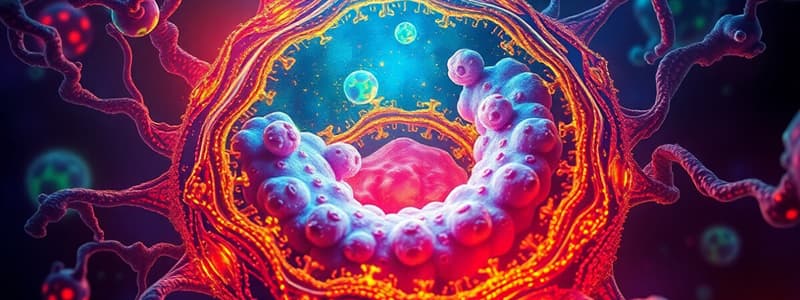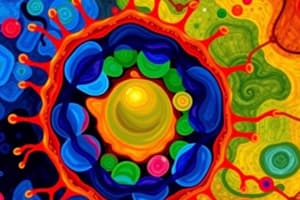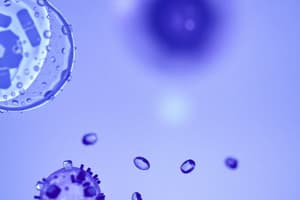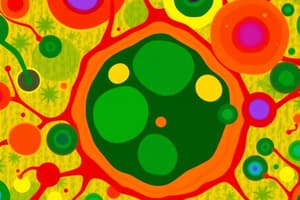Podcast
Questions and Answers
Which of the following is NOT a characteristic of prokaryotic cells?
Which of the following is NOT a characteristic of prokaryotic cells?
- They have a cell membrane.
- They have cytoplasm.
- They have a nucleus. (correct)
- They have a cell wall.
What is the main difference between eukaryotic and prokaryotic cells?
What is the main difference between eukaryotic and prokaryotic cells?
- Eukaryotic cells have a nucleus, while prokaryotic cells do not. (correct)
- Eukaryotic cells have a cell membrane, while prokaryotic cells do not.
- Eukaryotic cells have a cell wall, while prokaryotic cells do not.
- Eukaryotic cells are much smaller than prokaryotic cells.
Which of the following parts is found in both animal and plant cells?
Which of the following parts is found in both animal and plant cells?
- Chloroplasts
- Nucleus (correct)
- Permanent vacuole
- Cell wall
What is the function of the cell membrane?
What is the function of the cell membrane?
What is the role of mitochondria in a cell?
What is the role of mitochondria in a cell?
Which of the following is NOT a characteristic of stem cells?
Which of the following is NOT a characteristic of stem cells?
What is the function of plasmids in bacterial cells?
What is the function of plasmids in bacterial cells?
What is the process by which a cell divides to produce two identical daughter cells called?
What is the process by which a cell divides to produce two identical daughter cells called?
Which of the following cells are specialized to carry out a specific function in animals?
Which of the following cells are specialized to carry out a specific function in animals?
What is the primary function of phloem cells in plants?
What is the primary function of phloem cells in plants?
What is the main importance of cell differentiation in organisms?
What is the main importance of cell differentiation in organisms?
In mature animals, what is the primary role of cell division?
In mature animals, what is the primary role of cell division?
Which of these statements accurately describes the difference between a light microscope and an electron microscope?
Which of these statements accurately describes the difference between a light microscope and an electron microscope?
What is the formula used to calculate magnification in microscopy?
What is the formula used to calculate magnification in microscopy?
Which of these prefixes represents the smallest unit of measurement?
Which of these prefixes represents the smallest unit of measurement?
How often can bacteria multiply under ideal conditions?
How often can bacteria multiply under ideal conditions?
What is the primary purpose of sterilizing petri dishes and culture media before use in microbiology experiments?
What is the primary purpose of sterilizing petri dishes and culture media before use in microbiology experiments?
What is the maximum temperature recommended for incubating bacterial cultures in school and college laboratories?
What is the maximum temperature recommended for incubating bacterial cultures in school and college laboratories?
Flashcards
Basic unit of life
Basic unit of life
Cells are the fundamental building blocks of all living organisms.
Mitosis
Mitosis
A process by which a cell divides to produce two identical daughter cells.
Stem cells
Stem cells
Undifferentiated cells that can develop into different cell types.
Eukaryotic cells
Eukaryotic cells
Signup and view all the flashcards
Prokaryotic cells
Prokaryotic cells
Signup and view all the flashcards
Cell membrane
Cell membrane
Signup and view all the flashcards
Chloroplasts
Chloroplasts
Signup and view all the flashcards
Cell wall
Cell wall
Signup and view all the flashcards
Cell Specialization
Cell Specialization
Signup and view all the flashcards
Examples of Specialized Cells
Examples of Specialized Cells
Signup and view all the flashcards
Cell Differentiation
Cell Differentiation
Signup and view all the flashcards
Microscopy Development
Microscopy Development
Signup and view all the flashcards
Electron Microscope
Electron Microscope
Signup and view all the flashcards
Magnification Calculation
Magnification Calculation
Signup and view all the flashcards
Aseptic Technique
Aseptic Technique
Signup and view all the flashcards
Binary Fission
Binary Fission
Signup and view all the flashcards
Zones of Inhibition
Zones of Inhibition
Signup and view all the flashcards
Culturing Microorganisms
Culturing Microorganisms
Signup and view all the flashcards
Study Notes
Cell Biology
- Cells are the fundamental units of all living things.
- Structural differences in cells allow them to perform specific functions.
- Gene control these differences within the nucleus.
- Mitosis is cell division that creates two identical cells, allowing growth.
- Stem cells, collected early in growth, are versatile and can develop into various cell types.
- Stem cell technology repairs damaged organs by growing new tissue.
Cell Structure
- Eukaryotes (plant and animal cells):
- Cell membrane
- Cytoplasm
- Nucleus containing genetic material
- Prokaryotes (bacterial cells):
- Much smaller than eukaryotes.
- Cytoplasm
- Cell membrane
- Cell wall
- Genetic material (single DNA loop, plus plasmids – small rings of DNA)
- No nucleus
Animal and Plant Cells
- Animal cells:
- Nucleus
- Cytoplasm
- Cell membrane
- Mitochondria
- Ribosomes
- Plant cells:
- All animal cell structures
- Chloroplasts
- Permanent vacuole (filled with cell sap)
- Cell wall (made of cellulose for support)
Cell Specialization
- Cells are specialized for specific roles.
- Examples in animals: sperm cells, nerve cells, muscle cells.
- Examples in plants: root hair cells, xylem cells, phloem cells
Cell Differentiation
- Cells differentiate (become specialized) during development.
- Most animal cells differentiate early in development.
- Many plant cells can differentiate throughout their life.
- Cell division in mature animals is mainly for repair and replacement.
- Specialized cells have specific structures to perform their functions.
Microscopy
- Microscopy techniques have advanced over time.
- Electron microscopes have greater magnification and resolution, allowing examination of sub-cellular structures.
- Microscopy calculations use: magnification = image size / real size
- Standard form may be needed for calculations.
Culturing Microorganisms (Biology Only)
- Bacteria reproduce rapidly by binary fission (every ~20 minutes).
- Bacteria culture methods include nutrient broth and agar gel plates.
- Uncontaminated cultures are key for testing disinfectants/antibiotics.
- Aseptic techniques are critical for uncontaminated cultures (sterilize equipment, secure lids).
- Petri dishes and media are sterilized before use.
- Inoculating loops are sterilized with flame.
- Lids are taped and stored upside down.
- Incubate at a maximum of 25°C in a lab environment.
- Bacteria population growth can be calculated if the division time is known.
- Cross-sectional area calculations using πr² may be needed.
- Experiments may investigate antiseptic/antibiotic effects on bacterial growth.
Studying That Suits You
Use AI to generate personalized quizzes and flashcards to suit your learning preferences.




